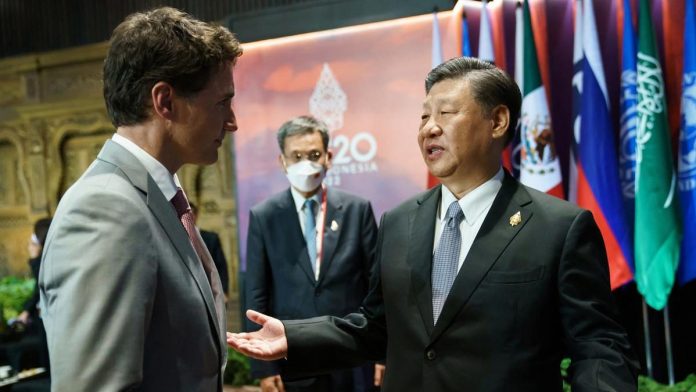Prime Minister of Canada Justin Trudeau’s government is boosting military spending and expanding the country’s trade ties in the Indo-Pacific region as part of a “generational” policy shift aimed at countering China‘s influence. Foreign Minister Melanie Joly released her nation’s Indo-Pacific Strategy Sunday morning, including nearly $ 1.7 billion (Canadian Dollar or CD 2.3 billion) in spending. That money is being used for more navy patrols in the region, better intelligence and cybersecurity measures, and increased cooperation with regional partners in the East and South China Seas.
The 26-page document — unveiled by Joly and a trio of other ministers in Vancouver, with Trudeau‘s defence chief holding a virtual briefing later on 27 November — includes a lengthy section on China, which it refers to as an “increasingly disruptive global power”.
It cites multiple military, security and economic threats posed by the country while acknowledging the need to work with it on issues such as climate change, global health, biodiversity and nuclear non-proliferation.
Joly, in an hour-long interview with Bloomberg News ahead of the strategy statement’s release, said the world’s geopolitical “tectonic plates” were shifting. That’s threatening international norms that have kept the world safe since World War Two, as well as creating supply chain uncertainty and inflation.
“When it comes to China, we know that there’s a battle of influence happening in the region,” she said on 25 November in Montreal. “So we have to step up our game.”
When Chinese president was rude to PM of Canada
Canada will toughen its rules around foreign investment and take other steps to defend itself from “foreign interference,” the document states. Its publication comes less than two weeks after Chinese President Xi Jinping confronted Trudeau on the sidelines of the G20 Summit in Indonesia, admonishing the Canadian leader for providing the media with information about an earlier discussion.
Joly told Bloomberg the encounter didn’t surprise her, as she has had “frank conversations” with her Chinese counterpart in the course of diplomacy.
“You saw what we see happening normally,” she said. “You just had a glimpse of the political reality.” She said crafting an Indo-Pacific strategy would have been fruitless without addressing China’s growing influence, “the elephant in the room.”
Canada to enhance diplomacy, trade, military cooperation in Indo-Pacific
Canada will increase its diplomatic and trade presence to create a more predictable environment for business investment in Asia, Joly said. It will invest CD 750 million in sustainable infrastructure projects, which it hopes will attract further capital from Canadian pension funds.
At the same time, increased military cooperation with regional partners will protect the country’s Pacific interests, just as alliances with Europe through the North Atlantic Treaty Organization, and the US through the North American Aerospace Defense Command, have historically protected its Arctic and Atlantic interests, she said. Canada will invest almost half a billion Canadian dollars over five years on enhanced defence in the region.
“For a long time we’ve defined ourselves through the relationship we have with Europe,” Joly said. “It is time to look towards the Pacific.”
The strategy contains a section devoted to deepening economic ties with India, and another devoted to Japan and South Korea — a neighbourhood it dubs the North Pacific.
Canada has struggled to diversify its Pacific trading relationships beyond China, its second-largest trade partner after the US. Merchandise trade with China totalled CD 125.8 billion in the last 12 months to September, representing about 8.6% of trade flows, according to Statistics Canada data. That compares to less than 7% from all other major Indo-Pacific countries combined — a proportion that is little changed since 1997, a time when Canada-China trade was minimal.
There are numerous planks in the strategy meant to grow Canada’s trade relationships, including a new series of “Team Canada” trade missions to bring business leaders to Indo-Pacific countries, and a CD 65.1 million programme to increase Canada’s science and research partnerships with South Korea, India, Japan, Singapore and Taiwan.
The CD 750 million infrastructure program is the largest ticket item in the plan and is part of Canada’s contribution to the $ 600 billion G7 infrastructure plan announced earlier this year to counter China’s Belt and Road program. Joly said she had met with major Canadian pension funds on 24 November — including the Ontario Teachers’ Pension Plan Board and the Caisse de Depot et Placement du Quebec — to start promoting the plan.
Blow hot, blow cold
Joly, who was appointed to the role in October 2021, said she had been tasked with rebuilding Canada’s relationship with China during a three-year chill after Canada’s arrest of Meng Wanzhou, Huawei Technologies Co.’s chief financial officer, on a US extradition request, and China’s subsequent detention of two Canadians, Michael Kovrig and Michael Spavor.
The initial reaction from corporate Canada was positive. But with Canada being pressed to help stabilize global energy markets with increased exports of liquefied natural gas, one of the country’s top business lobby groups flagged a potential missed opportunity on energy policy.
“We would have liked to see an express commitment by the government to provide secure supplies of Canadian LNG to our allies in the region along with specific details of how it will expedite the approval of Pacific-coast energy export infrastructure,” Goldy Hyder, president and chief executive officer of the Business Council of Canada, said in an emailed statement.



You must log in to post a comment.